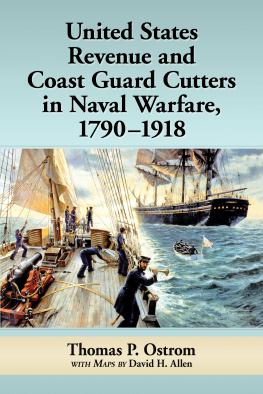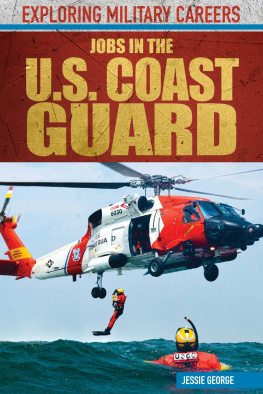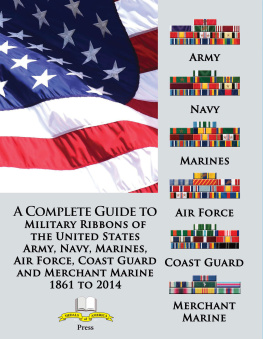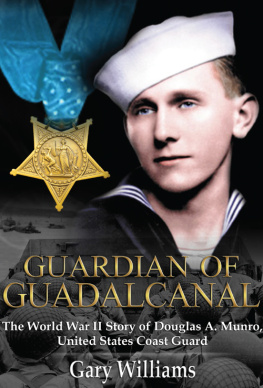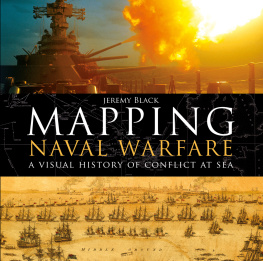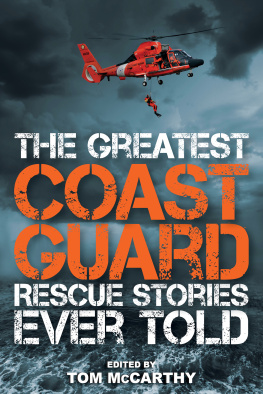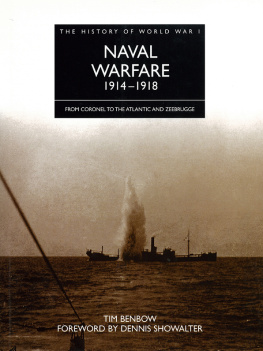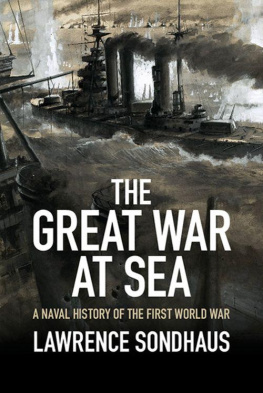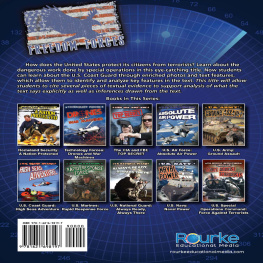
UNITED STATES REVENUE AND COAST GUARD CUTTERS IN NAVAL WARFARE, 17901918
Thomas P. Ostrom
with Maps by David H. Allen

McFarland & Company, Inc., Publishers
Jefferson, North Carolina
ALSO OF INTEREST AND FROM MCFARLAND
United States Coast Guard Leaders and Missions, 1790 to the Present, by Thomas P. Ostrom and John J. Galluzzo (2015)
The United States Coast Guard and National Defense: A History from World War I to the Present, by Thomas P. Ostrom (2012)
The United States Coast Guard in World War II: A History of Domestic and Overseas Actions, by Thomas P. Ostrom (2009)
All photographs are from the United States Coast Guard unless otherwise noted.
LIBRARY OF CONGRESS CATALOGUING DATA ARE AVAILABLE
BRITISH LIBRARY CATALOGUING DATA ARE AVAILABLE
e-ISBN: 978-1-4766-3075-5
2018 Thomas P. Ostrom. All rights reserved
No part of this book may be reproduced or transmitted in any form or by any means, electronic or mechanical, including photocopying or recording, or by any information storage and retrieval system, without permission in writing from the publisher.
Front cover: Inspection of a Merchant Ship, 1861, oil on canvas, 38" 47" (United States Coast Guard)
McFarland & Company, Inc., Publishers
Box 611, Jefferson, North Carolina 28640
www.mcfarlandpub.com
Acknowledgments
The motivation to write this book on 19th century naval warfare came from many sources. One of them came as a result of my membership in the Civil War Round Table of Rochester (RCWRT), Minnesota. Richard G. Krom and his spouse, program director Sharon Krom, administer the RCWRT, and Sharon contributed to Richards book, The First Minnesota, Second to None. (The book was published in 2010 by the author and produced by Bang Printing in Brainerd, Minnesota; the couples son, James Krom, the proprietor of Natural Images in Rochester, created the cover illustration.) First Minnesota is based on letters home written by Edward H. Bassett, a Civil War soldier in the First Minnesota Regiment and Richard Kroms great-grandfather.
Troop ships transported Bassett to and from his home and into the maritime domains of the Potomac, James, and York rivers, Chesapeake Bay, and the coastal Atlantic. As the author of books on U.S. revenue cutter and U.S. Coast Guard history, I was drawn to the maritime experiences of the Minnesota soldiers as they traversed rivers and waterways on civilian steamships, military and naval transports, and boats in a variety of logistical and tactical missions. Edward Bassetts letters and Kroms narrative segues described pontoon bridge building across strategic rivers. Bassetts accounts of his travels included references to the paddle-wheel steamers SS Atlantic, SS Baltic, and SS Empire City and the wood-hulled and iron-clad U.S. Navy ships USS Monitor, USS Minnesota, USS Keokuk, and USS Essex.
My subsequent research on the age of sail and coal-fueled, steam-powered ships and the transition from wooden-hulled to iron combat vessels led to this book and the joint missions of the U.S. Navy and the U.S. Revenue Cutter Service and U.S. Coast Guard throughout the 19th century and into the 20th. The wars that occurred in that time frame include the Quasi-War with France (1800), the War of 18121815, the Seminole Wars of the 1830s and after, naval missions against piracy and slave ships, the U.S.Mexican War (18461848), the Civil War (18611865), the Spanish-American War (1898), and the entry in 1917 of the United States into the Great War of 19141918 (World War I).
I have been greatly influenced by David Howard Allen, a retired IBM electrical engineer, military history scholar, gamer, lecturer, and supporter of veterans and veteran organizations. Dave has taken course work from American Military University and has supported and encouraged me in my writing, contributed greatly to my knowledge of military history and operations, and attended my oral presentations and classes locally and regionally, including the National World War II Museum in New Orleans, Louisiana, and the U.S. Navy Memorial in Washington, D.C.
David Allen is the illustrator and cartographer for this book; he has graphic design experience in technical papers, is the author or coauthor of 20 published papers, and the inventor or co-inventor of numerous patents. Dave has written extensively about military history, including a published paper, Twilight of the Luftwaffe, about the rise and fall of the German military machine.
David Allens respect and support for the military was inspired by his father, Lieutenant Colonel John Charles Allen (U.S. Army), and three brothers who served in the military. Colonel Allen served as an enlisted man in the U.S. Army Air Force in World War II, then the National Guard, and as a commissioned officer in the Korean War (19521953). Colonel Allen graduated from the U.S. Command and General Staff College, served on the general staff at the Pentagon in Washington, D.C., and continued his military career until 1968. LTC Allen was buried in Arlington National Cemetery in 2016.
Medical issues prevented David Allen from directly serving in the military and naval forces of the United States, but his siblings served. Davids brother John Charles Allen, Jr., was a midshipman first class at the U.S. Naval Academy until his tragic death in an automobile accident. Jeffrey Lewis Allen graduated from the U.S. Air Force Academy and served as a commissioned officer for several years. James Edward Allen graduated from the U.S. Air Force Reserve Officer Training Corps program at the University of Kansas and served as a commissioned officer.
Captain Joseph Connell served in Vietnam as a U.S. Air Force helicopter rescue pilot. His friendship, service, and responsibilities taught me much about command, courage and leadership responsibilities, and he further enriched me with his research on military history. After a sales and administrative career at IBM, Joe immersed himself in veterans affairs, historical research, air shows, and piloting his self-built aircraft. His knowledge and respect for the Coast Guard was inspirational. Captain Connell was familiar with the U.S. Coast Guard in Vietnam and the aviators who flew helicopters on search and rescue (SAR) missions. Mr. Connell supported me in my professional activities and in our joint historical research projects. Joe participated in the historic Veteran Honor Flights to Washington, D.C., and has given presentations on military issues and history.
Master Technician Senior Chief Tina M. Claflin, U.S. Coast Guard (Ret.), inspired and supported my writing and speaking. Senior Chief Claflins career included sea duty on the U.S. Coast Guard Academy training sailing ship USCGC Eagle (WIX-327) and other cutters, leadership in Coast Guard womens support programs. She was among other distinguished female members of the military services honored by the Congressional Womens Caucus. Senior Chief Claflin, a Rhinelander, Wisconsin, native, enriched my presentations at the U.S. Navy Memorial in Washington, D.C., and I have encouraged Chief Claflins writing and research.
The staff at the History Center of Olmsted County in Rochester, Minnesota, has provided the staff and facilities for historical presentations and research. Program coordinator Aaron Saterdalen has encouraged this author by providing speaking and research opportunities, as has HCOC curator Daniel Nowakowski.
Next page
